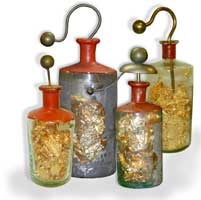Science Fiction
Dictionary
A B C D E F G H I J K L M N O P Q R S T U V W X Y Z
Latest By
Category:
Armor
Artificial
Intelligence
Biology
Clothing
Communication
Computers
Culture
Data Storage
Displays
Engineering
Entertainment
Food
Input Devices
Lifestyle
Living Space
Manufacturing
Material
Media
Medical
Miscellaneous
Robotics
Security
Space Tech
Spacecraft
Surveillance
Transportation
Travel
Vehicle
Virtual
Person
Warfare
Weapon
Work
"Evolutionary success ... is going to absolutely require mobility on, at a minimum, an interplanetary scale. We either go or we die out."
- Richard Morgan
| Leyden Ball | ||
| Device for hunting underwater; transfers a powerful electrical charge to the prey. |
Really the grandfather of the taser.
In this excerpt, Captain Nemo is explaining to his reluctant guest Monsieur Arronax, how it is possible to use a rifle underwater.
| "Besides M. Aronnax, you must see
yourself that, during our submarine hunt, we can spend but little air
and but few balls."
"But it seems to me that in this twilight, and in the midst of this fluid, which is very dense compared with the atmosphere, shots could not go far, nor easily prove mortal." "Sir, on the contrary, with this gun every blow is mortal; and, however lightly the animal is touched, it falls as if struck by a thunderbolt." "Why?" "Because the balls sent by this gun are not ordinary balls, but little cases of glass. These glass cases are covered with a case of steel, and weighted with a pellet of lead; they are real Leyden bottles, into which the electricity is forced to a very high tension. With the slightest shock they are discharged, and the animal, however strong it may be, falls dead. I must tell you that these cases are size number four, and that the charge for an ordinary gun would be ten." |
| Technovelgy from 20,000 Leagues Under the Sea,
by Jules Verne. Published by Pierre-Jules Hetzel in 1875 Additional resources -
|
The Leyden jar is a cylindrical container made of a dielectric (an insulator, like glass) with a layer of metal foil on the inside and outside. With the outside surface grounded, a charge is applied to the inside surface. This gives the outside an equal but opposite charge. When the outside and inside surfaces are connected by a conductor, the stored electrical energy is discharged. It was the world's first working capacitor.

Decorative mid-19th century Leyden Jars
The Leyden jar was first discovered by Ewald Georg von Kleist, a German inventor. However, Pieter van Musschenbroek of the University of Leyden discovered the Leyden jar independently in 1746 and the name remains. Find out more about the Leyden Jar at Faradnet.
The Leyden jar was used in the first atom smasher, built at Cambridge University. This device used banks of them as condensers and could store up to one million volts.
And, for those of you who long to join Captain Nemo and hunt in the ocean depths, conveniently located just outside your baroque 19th century submarine, you can get close with the Aquarius Underwater Laborator Virtual Tour (requires Ipix plug-in). Or, read more about the Captain Nemo's submarine - the Nautilus.
Comment/Join this discussion ( 2 ) | RSS/XML | Blog This |
Additional
resources:
More Ideas
and Technology from 20,000 Leagues Under the Sea
More Ideas
and Technology by Jules Verne
Tech news articles related to 20,000 Leagues Under the Sea
Tech news articles related to works by Jules Verne
Leyden Ball-related
news articles:
- Inertial Capacitive Incapacitor: HomeSec Does Verne
- Piezer - Homeland Security Orders Verne's 1875 'Leyden Ball'
- Lynntech Non-Lethal Weapon - Jules Verne Right Again
- Long Range Stunners - Again
- TASER XREP Neuro-Muscular Incapacitation
- CAV-X Supercavitating Ammo Deadly Underwater
- SPECTER Electroshock Round Fireable From Shotgun
| Is The Seattle Ultrasonics C-200 A Heinlein Vibroblade? |
| Man Builds 200 Foot Basement Firing Range |
| Russians Create Robot Tank Platoons |
| Unmanned Boats Attack At Sea |
Want to Contribute an
Item?
It's easy:
Get the name of the item, a
quote, the book's name and the author's name, and Add
it here.
| <Previous | Next> |
|
|
|
Technovelgy (that's tech-novel-gee!) is devoted to the creative science inventions and ideas of sf authors. Look for the Invention Category that interests you, the Glossary, the Science Fiction Invention Timeline, or see what's New.
|
Science Fiction
Timeline
1600-1899
1900-1939
1940's 1950's
1960's 1970's
1980's 1990's
2000's 2010's
'Jason had been guiding the caravan of cars as usual...'
"The robot solemnly hit a ball against the wall, picked it up and teed it, hit it again, over and again...'
'There was a wall ahead... It was riddled with holes that were the mouths of tunnels.'
'...support the interior human structure against Jupiterís pull.'
'Anything larger than a BB shot it picked up and placed in a tray...'
'The German chemists have discovered how to supply the needed elements in compact, undiluted form...'
'Compounds devised by the biochemists for the rapid building of bone...'
'The car faltered as the external command came to brake...'
'It is about the size and shape of a kitchen stool, gyro-stabilized...'
